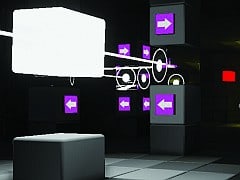Video Gamer is reader-supported. When you buy through links on our site, we may earn an affiliate commission. Prices subject to change. Learn more
Q.U.B.E. understands that the best incentive to complete a puzzle is having the solution in sight, more so than most other games I can think of. While each problem is held within a single room, it’s also contained within a very compact area. From the moment you enter, your brain is figuring out what to do and where to go. That’s why it’s a compulsive thing – it’s the same reason why, when you find a Rubik’s cube during your annual clean, you spend a good 10 minutes turning those rows around, trying to at least get one face a solid colour, before discarding it for another year.
Here, your aim is simply to manipulate your environment until you slip out through the exit door, leaving in your wake a metaphorical Rubik’s cube – aesthetically ordered and resolutely solved. Q.U.B.E.’s chambers are built out of grids of pristine white blocks, occasionally interspersed with those of other colours. The latter have unique properties and can be coaxed into action using a pair of mysterious gloves that you find at the start of the game: Red blocks are single pillars that protrude in increments; blue are jump-pads that can be primed; yellow are staircases whose highest point is dictated by the end you activate; and purple rotate the walls.
It’s at this point that you read that description, glance at the odd screenshot, and raise your hand, the word ‘Portal’ hovering on your lips with the urgency of the class know-it-all. It’s a word worth saying, because Q.U.B.E is a game that probably wouldn’t exist were it not for G.L.A.D.O.S. and co.
So much is borrowed, repurposed or taken from Valve’s compact masterpiece: The overly white and sterile aesthetic, the way each room is structured, the self-contained puzzles. But where Portal stuck to its core mechanic of making one portal here and one portal there, and then trying to wrap your mind around the fact that “here” and “there” are now the same thing, Q.U.B.E. sets its expectations a little higher.
While the fundamentals never leave the manipulation of those four coloured cubes, no two puzzles tread the same ground. The game is short, clocking in at just over two hours, but the depth and breadth of content is alarming, constantly blindsiding you with new ideas that force you to reconsider whatever patterns you’d established. The best example of this is Sector 5, which plunges you into almost complete darkness save for the objects you can affect, and even those can only be lit up one at a time.
It forces you to adapt, quickly, never really getting comfortable but building enough on the fundamentals that you don’t feel overwhelmed. Which is just what you want a puzzle game to do: Challenge without frustrating. By forcing each puzzle into smaller, more manageable chunks, what initially looks impossible becomes a series of solvable problems. It’s all rather elegant.
It’s not without flaws, though. The jump pads in particular never let you know how far they’re going to fling you, whether it’s just up to the next ledge or all the way across the room, which, at least initially, forces some puzzles to be more confusing than they need to be. And some of the later levels require knowledge of how the physics are going to behave, knowledge that you have no means of obtaining in advance, leading to a temporary dead end where there should be none.
The most obvious omission, however, is the lack of an explicit narrative. With Portal remembered more for its story than its puzzling, Q.U.B.E.’s almost pure focus on puzzle-solving can leave you feeling short-changed. And while this is a somewhat unfair comparison, driven by a dearth of first person puzzle-platformers, it puts the game in a no-win situation. It can either attempt a narrative and inevitably come up short, or do nothing, and have that lack of story constantly in the player’s mind.
Somehow, Q.U.B.E. all but avoids either fate. There is a narrative, but it’s entirely environmental, ambiguous enough that any plot you find is based on assumption. The testing center tells its own story, and I can’t think of a better way for the developers to insert a narrative without unloading into their own foot.
Fundamentally, this is a very satisfying puzzle game, and one that manages to stay surprising throughout by keeping things incredibly tight. It escalates from the start and doesn’t stop, providing more than enough reason to spend a couple of hours pushing around brightly covered blocks. After all, you’ve been practising since you were a toddler.

/https://oimg.videogamer.com/images/bf68/qube_1.jpg)